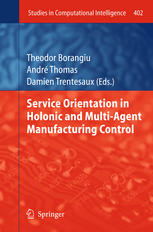

Most ebook files are in PDF format, so you can easily read them using various software such as Foxit Reader or directly on the Google Chrome browser.
Some ebook files are released by publishers in other formats such as .awz, .mobi, .epub, .fb2, etc. You may need to install specific software to read these formats on mobile/PC, such as Calibre.
Please read the tutorial at this link: https://ebookbell.com/faq
We offer FREE conversion to the popular formats you request; however, this may take some time. Therefore, right after payment, please email us, and we will try to provide the service as quickly as possible.
For some exceptional file formats or broken links (if any), please refrain from opening any disputes. Instead, email us first, and we will try to assist within a maximum of 6 hours.
EbookBell Team

5.0
90 reviewsService orientation is emerging nowadays at multiple organizational levels in enterprise business, and it leverages technology in response to the growing need for greater business integration, flexibility and agility of manufacturing enterprises.
The Service Oriented Architecture (SOA) analysed throughout the book represents a technical architecture, a business modelling concept, a type of infrastructure, an integration source and a new way of viewing units of automation within the enterprise. The primary goal of SOA is to align the business world with the world of information technology in a way that makes both more effective.
The service value creation model at enterprise level consists of using a Service Component Architecture for business process applications, based on entities which handle services. In this view a service is a piece of software encapsulating the business/control logic or resource functionality of an enterprise entity that exhibits an individual competence and responds to a specific request to fulfil a local (operation) or global objective (batch production). The value creation model is based on a 2-stage approach:
• Agentification: complex manufacturing processes are split in services provided by informational agents which are discovered, accessed and executed. This leads to a modular, reusable, agile and easy integrate integration.
• Holonification: holons link the material flow and physical entities of the manufacturing processes with the informational part (IT services realized by distributed intelligence) facilitating thus traceability the developing of flexible control systems.
This book gathers contributions from scientists, researchers and industrialists on concepts, methods, frameworks and implementing issues addressing trends in the service orientation of control technology and management applied to manufacturing enterprise.
This book gathers contributions from scientists, researchers and industrialists on concepts, methods, frameworks and implementing issues addressing trends in the service orientation of control technology and management applied to manufacturing enterprise.